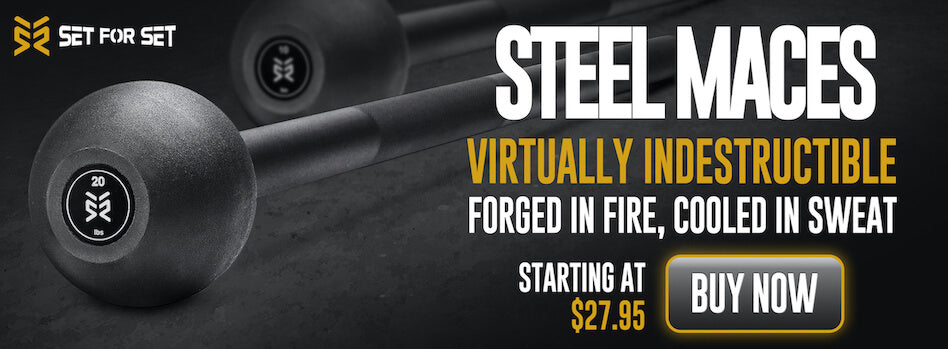Want your perfect workout program?
Take QuizWhat is a Macebell?

Written by Sam Coleman | Co-founder
Fact checked by Kirsten Yovino, CPT Brookbush Institute
 FACT CHECKED
FACT CHECKED
What is a Macebell?
To answer this question, we first have to go back in history to the macebell's origins…
The macebell derives from an ancient weapon known simply as a “mace”.
A mace is a bludgeon, which is a type of blunt weapon that uses a heavy head attached to the end of a handle.

The use of maces in warfare dates back thousands of years, and was used all the way up to as recent as World War I. Many ancient civilizations throughout history had maces in their arsenal.
Maces came in various sizes and styles, depending on the culture and its use. There were battle maces with long handles and short handles, the head of the maces were round, spiked, pear shaped, or flanged shape. Eventually, maces even became a symbol for ceremonial use. These ceremonial maces were richly ornamented and made from silver.
Most notably, Hindu and Persian warriors wielded maces during battle due to the serious damage it could inflict on their opponents.
In India, clubs or blunt maces are known as Gadas.
Maces were also used as a training tool for warriors because the swimming motion directly transferred to their battlefield prowess - rotational strength and power! Essentially, it was functional training at its finest.
The Mace as a Training Tool
Maces eventually became one of the first weight training tools known to man. And in this sense, we are talking specifically for fitness and sport, not just battle.
Pelhwani wrestlers on the subcontinent of India started employing the mace as an essential piece of equipment for their training regimen around 100 years ago.
Now, let’s call it a Gada when referring to the mace's fitness origins as that is what it is called in India and since they were the first to use it as a fitness tool it is only right...
Gadas are still one of the main tools used for the wresters of North India.
The Great Gama is easily the most famous Pelhwani wrestler, having gone undefeated during his 50 year career. The Great Gama is widely known for routinely and systematically using Gadas during his workouts.
Although Gadas have been a popular fitness tool in the North of India for a hundred years or so, they didn’t gain traction in the West until this past decade.
In recent years, “Gadas” have gained a lot of popularity in the western world.
But here, we don't call them Gadas, we call them MACEBELLS (or Steel Maces).
Martial artists, functional fitness trainers, athletes and workout enthusiasts have begun incorporating macebells into their training as they provide dynamic, high-intensity full body workouts that build rotational power, core strength, cardiovascular health, and more.

Macebell Design & Features
Now, let's be clear - macebells aren’t exactly the same as Gadas, as they are made differently. Nevertheless, the function and nature of the design are essentially the same. They are long handles with a heavy head at the end, just like battle maces. This means its an offset weight with the majority of the weight being in the head.
Let’s talk about the features of a macebell...
Unlike Gadas, which are made using a bamboo stick and concrete, macebells are made from cast-iron and steel.
Macebells have a metal head (or bell) that is welded to a strong hollow metal handle. The handles are typically not as long as Gadas but they are thicker and knurled for better grip. The thicker handles also work grip strength more.
Gadas have bigger heads than macebells too, as cast iron is heavy so it requires less volume to get the same weight.
Macebell Weight
Gadas weight sizes typically range from 15lbs all the way up to 100lbs (which is ridiculously heavy).
Macebells normally weigh 7, 10, 15, 20, 25, or 30lbs. But there are some companies that make even heavier macebells. That said, even advanced athletes will never go above 25-30lbs.
Due to the change in material and design, Macebells are actually a lot more versatile than Gadas. They can be used in many new, useful ways that the Gada can't. Gadas are solely made for swinging.

Macebells = Offset Weight Training
Macebells have an uneven weight distribution with most of the weight being in the head of the mace. The weight displacement activates the vital yet often overlooked stabilizer muscles surrounding our joints. This makes the macebell one of the most efficacious tools for building balance, coordination, and core and shoulder strength & stability.
Moreover, the offset weight of the macebell makes for extremely dynamic movements patterns with an ability to produce torque, which ultimately leads to ferocious rotational power. For many athletes, rotational power is the key to success in their sport.
Macebell Swings
The best and most traditional macebell exercises are the 360 and 10-to-2. Here are videos of these two exercises…
These are what the Gada was made for. Macebell swings like the 360 and 10-to-2 will give you all of the benefits mentioned above - core strength, shoulder strength, rotational power, PLUS, it will work your grip strength and endurance like crazy and give your shoulders more mobility and fluidity, which is great for athletes, MMA fighters, Yogis and anyone who does overhead lifts with barbells.
Macebell Uses & Benefits
Although we’ve explained some of the benefits of the mace, there’s much more…
Macebells are very versatile in their uses and benefits.
Here are some of the main benefits and uses…
- Improving Core Strength
- Increasing Core & Shoulder Stability (works deep stabilizer muscles)
- Building Incredible Grip Strength
- Developing Serious Rotational Power (great tool for the transverse plane)
- Enhancing Joint Health
- Cardiovascular Training
- Metabolic Training
- Multiplanar Training
- Balance Training
- Flows & Sequence Training
- Shoulder Prehab
- Warming Up
Macebells combine mobility training with strength training, so this is a fantastic implement for weightlifters and athletes alike.
We won’t go too in-depth on the benefits and uses in this post because we have already written about those two topics exclusively.
Where to Buy a Macebell?
We sell macebells ranging from 7 to 30 pounds. We take great pride in the craftsmanship of our macebells, so we are confident that you will be thrilled when our macebell arrives at your doorstep.
More Steel Mace Resources:
- Why SET FOR SET is the best place to buy a mace
- Why Fixed Weight Maces are Better Than Adjustable Macebells
“What Size/Weight Macebell Should I Get?”
This is a very common question...
When it comes to macebells, due to the uneven load, a 10-15lb mace is not going to feel the same as a 10-15lb dumbbell which has an even load and balanced proportions.
So, we highly recommend that you don’t overestimate your strength when it comes to macebell training. It’s a whole different beast.
For most men and women, we recommend starting with a 10lb mace. For men who are bigger and stronger, a 15lb mace is a good starter, but you will be limited in your ability to whip it around if you are looking to “flow”. For women who are new to unconventional training and/or fitness, we recommend a 7lb mace.
All in all, if you want to learn how to use the mace safely and effectively, you need to start with a considerably lighter weight than you may expect. But don’t worry, it will still be very challenging! You’d never imagine 10lbs being so difficult to manage. However, a macebell is an awkward training tool, so it is!
Plus, the great thing about the mace is, you can increase the difficulty/resistance by moving your hands closer to the end of the handle. Essentially you can control how offset it is by how you position your hands. So if a weight is too difficult for one movement, you can change your grip, and vice versa.
Related: What Size Macebell Should I Get?
Training Guide
Get our 84-page Macebell Training Guide (digital download). Our training guide will teach you everything you need to know about the mace, including hand placements, starting positions, and grip orientation. It has tons of video exercises, and it will teach you how to do macebell flows/complexes and create macebell workouts. So, you can become a pro mace athlete/trainer in no time.
We also have a lot of free resources for you to learn from…
Macebell Resources
Exercises:
- 16 Best Macebell Exercises
- How to perform a Mace 360s and 10-to-2s (Practice Moves and Proper Form)
- How to Flow With A Macebell
- Macebell Core Exercises
- Macebell Grip Exercises
- Isometric Exercises
- Transverse Plane Exercises
- Balance Training
- Tire Slams
- Macebell Targeted Exercises (Chest, Back, Legs, Shoulders, Arms)
- 66 Macebell Swing Variations
- Shoulder Rehab Exercises
Workouts:
- 30 minute Full Body Workout (Full Length)
- Beginner Macebell Workout
- Intermediate Macebell Workout
- Advanced Macebell Workout
- Macebell Metabolic Conditioning Workout
- Game of Thrones Macebell Workout
- Bodybuilding Chest and Back Superset Workout with Macebell
- How To Create Complex Mace Workouts
Workout Plans:
- 4 Week Macebell and Bodyweight Workout Plan
- 6 Week Macebell and Bodyweight Workout Plan to Get Ripped
- 5 Steel Mace Workout Methods
Macebell Competitions

Macebell competitions are growing. They are similar to kettlebell competitions (and are often done at the same events). You get on stage with other competitors and perform 360s or 10 to 2s for as many reps as possible in 5 minutes.
Related: How to Join a Macebell Competition
We go over the different competitions available across the globe, the rules, what maces they use, and everything else you’ll need to know to join a macebell competition.
Macebell Reviews

We reached out to the mace community and those who’ve bought maces from us to get some feedback on how their training is going for themselves and their clients.
Here are 9 Macebell Reviews from real trainers and fitness enthusiasts like yourself.
More Macebell Resources:
- Tips for Steel Mace Beginners
- Top Instagrams to Follow For Mace Training Education, Motivation and Inspiration
- Find a Macebell Gym or Trainer in Your Area


Also in Blog
Recent Articles
-
Calories In, Calories Out Myth: Fact or Fiction?April 08, 2025
-
Cardio Or Strength Training: What's Better For Weight Loss?April 03, 2025
Must Reads
-
Mr Olympia 2024: What to Expect This Year (Oct. 10-13, 2024)September 11, 2024
-
What Can Walking For 1 Hour Everyday Do For You? My ExperienceFebruary 28, 2024
-
The Ultimate "Bro Split" Workout Plan (Backed By Science)August 05, 2023
- Blog
- Exercises
- Workouts
- Meal Plans
- SFS Programs
- Apparel
- About Us
- FAQ
- Shipping
- Warranty
- Contact Us
- Terms & Conditions
- Privacy Policy
- Affiliates
- SFS UGC Policy
- SFS MBG Policy
- Disclosures
- Legal Disclaimer
Sign up to get the latest on sales, new releases and more…
© 2025
SET FOR SET.
Powered by Shopify

















Sam Coleman
Author